Books
Books

In Thrall
Dear Miss Maxfeld . . . What I’m really afraid of is that I am a homosexual human being. I wish you were one too but I don’t think it’s possible there could be so many in one school, do you? Probably there is only one person who is homosexual in one place at one time and that one person (I am afraid) is me . . .
After sixteen-year-old Lynn writes her thirty-seven-year-old English teacher a letter they embark on one of the funniest and saddest love affairs in fiction, shrouded in secrecy and guilt. Set in the year Kennedy was shot, all Lynn knows about “lezbos” is that they wear their hair in crew cuts, buy suits like her father’s, and sprout mustaches over their upper lips. Trying to pass, Lynn continues to neck with her boyfriend and make bigoted jokes with her friends. Feigning innocence with her parents, each night she checks the mirror for tell-tale signs of perversion. Profound, witty, poignant, and highly charged, In Thrall is the first in Jane DeLynn’s trilogy of novels on sexuality and authority. It is as believable in its depiction of a closeted teen as it is heartbreaking.
With an introduction by Colm Tóibín
Flawless comic timing. —Colm Tóibín, from the Introduction
All Lynn’s phobias, aversions and hang-ups make her exaggerated but real . . . The great triumph of this novel is that DeLynn has captured the way adolescents felt, talked, and behaved during the early 1960s. —San Francisco Chronicle
A dazzlingly gritty exposure of a girlhood experience usually neglected by both private and public consciousness. —Reba Maybury

S.C.U.M. Maniifesto
An A6 pocket pamphlet edition of Valerie Solanas’ diatribe against men and the world they have made.
This limited edition has a misprint on the front cover.
In 1967 Valerie Solanas wrote an essay, both stringent and ironic – critiquing men, and the way the male-dominated scientific and academic world wrote about women. The Society for Cutting Up Men was her proposed solution. Deeply sincere and roguishly tongue-in-cheek, it is an essay worth reading, both for its insight into the mind of a person who had undergone and would undergo significant trauma in her life, and also inflict trauma on others.
Valerie Jean Solanas was born on April 9th, 1936. She’s best known for writing The SCUM Manifesto, and of course, attempting to murder an artist called Andy Warhol, in 1968. Solanas had an extremely troublesome childhood. Abused by her father and grandfather, she then had a volatile relationship with her mother and stepfather after her parents’ divorced. Solanas came out as a lesbian in the 1950s and relocated to Berkeley, California, where she wrote SCUM Manifesto, which urged women to “overthrow the government, eliminate the money system, institute complete automation and eliminate the male sex.

Salvage: Readings from the Wreck
Dionne Brand explores English and American literature, and the colonial aesthetic that shaped her sense of self and the world, of what was possible and what was not.
In Salvage: Readings from the Wreck, Dionne Brand’s first major book of nonfiction since her classic A Map to the Door of No Return, the acclaimed poet and novelist offers a bracing look at the intersections of reading and life, and what remains in the wreck of empire. Blending literary criticism and autobiography-as-artifact, Brand reads Aphra Behn’s Oroonoko, Daniel Defoe’s Robinson Crusoe, and Jane Austen’s Mansfield Park, among other still widely studied works, to explore encounters with colonial, imperialist, and racist tropes from the seventeenth to the nineteenth centuries—tropes that continue in new forms today. Brand vividly shows how contemporary practices of reading and writing are shaped by the narrative structures of these and related works, and explores how, in the face of this, one writes a narrative of Black life that attends to its own consciousness and expression.
With the power and eloquence of a great poet coupled with the rigor of a deep and subtle thinker, Brand reveals how she learned to read the literature of two empires, British and American, in an anticolonial light—in order to survive, and in order to live.
This is the library, the wreck, and the potential for salvage she offers us now, in a brilliant, groundbreaking, and essential work.

How to Tell When We Will Die: On Pain, Disability, and Doom
The long-awaited essay collection from one of the most influential voices in disability activism that detonates a bomb in our collective understanding of care and illness, showing us that sickness is a fact of life.
In the wake of the 2014 Ferguson riots, and sick with a chronic condition that rendered them housebound, Johanna Hedva turned to the page to How do you throw a brick through the window of a bank if you can’t get out of bed? It was not long before this essay, “Sick Woman Theory”, became a seminal work on disability, because in reframing illness as not just a biological experience but a social one, Hedva argues that under capitalism—a system that limits our worth to the productivity of our bodies—we must reach for the revolutionary act of caring for ourselves and others.
How to Tell When We Will Die expands upon Hedva’s paradigm-shifting perspective in a series of slyly subversive and razor-sharp essays that range from the theoretical to the personal—from Deborah Levy and Susan Sontag to wrestling, kink, mysticism, death, and the color yellow. Drawing from their experiences with America’s byzantine healthcare system, and considering archetypes they call The Psychotic Woman, The Freak, and The Hag in Charge, Hedva offers a bracing indictment of the politics that exploit sickness—relying on and fueling ableism—to the detriment of us all.
With the insight of Anne Boyer’s The Undying and Leslie Jamison’s The Empathy Exams, and the wit of Samantha Irby, Hedva’s debut collection upends our collective understanding of disability. In their radical reimagining of a world where care and pain are symbiotic, and our bodies are allowed to live free and well, Hedva implores us to remember that illness is neither an inconvenience or inevitability, but an enlivening and elemental part of being alive.

An Archive of Feelings
In this bold new work of cultural criticism, Ann Cvetkovich develops a queer approach to trauma. She argues for the importance of recognizing—and archiving—accounts of trauma that belong as much to the ordinary and everyday as to the domain of catastrophe. An Archive of Feelings contends that the field of trauma studies, limited by too strict a division between the public and the private, has overlooked the experiences of women and queers. Rejecting the pathologizing understandings of trauma that permeate medical and clinical discourses on the subject, Cvetkovich develops instead a sex-positive approach missing even from most feminist work on trauma. She challenges the field to engage more fully with sexual trauma and the wide range of feelings in its vicinity, including those associated with butch-femme sex and aids activism and caretaking.
An Archive of Feelings brings together oral histories from lesbian activists involved in act up/New York; readings of literature by Dorothy Allison, Leslie Feinberg, Cherríe Moraga, and Shani Mootoo; videos by Jean Carlomusto and Pratibha Parmar; and performances by Lisa Kron, Carmelita Tropicana, and the bands Le Tigre and Tribe 8. Cvetkovich reveals how activism, performance, and literature give rise to public cultures that work through trauma and transform the conditions producing it. By looking closely at connections between sexuality, trauma, and the creation of lesbian public cultures, Cvetkovich makes those experiences that have been pushed to the peripheries of trauma culture the defining principles of a new construction of sexual trauma—one in which trauma catalyzes the creation of cultural archives and political communities.

Le Chauffage #3 - Day Job
Francesca Percival, Felix Rapp and 1 more
The third issue of Le Chauffage is an inquiry into the relationship between the practices of artists/ writers and their day jobs. This subject stems from a question fundamental to the existing mandate of Le Chauffage: 'how do you keep warm?' and subsequently, 'how do you pay the bills?' As these perennial concerns occupy our everyday lives, we ask artists/writers to consider the influence that their day jobs, side hustles, creative or non- creative forms of employment have on their respective practices.
This issue tries to account for the significant ways in which complex economic realities come to shape the art we produce, look at, and discuss. How do we deal with limited time and resources? How do we reclaim and steal time back? How do our day jobs shape and influence what we make? How do we subvert the means of production of the workplace? Can the constraint of a day job also be a way to alleviate the pressure of professionalising?
With contributions by Daniel Bozhkov, Nathan Crompton Pippa Garner, Chauncey Hare Marisa Kriangwiwat Holmes, Garrett Lockhart, Jannis Marwitz Reba Maybury, Tiziana La Melia, Dan Miller, Ragen Moss, Jean Luc Moulène, Jean Katambayi Mukendi Paul Niedermayer, Sophie Nys, Megan Plunkett, Chris Reinecke, Jacquelyn Zong Li Ross On Gabrielle L Hirondelle Hill Margaux Schwarz, Eleanor Ivory Weber James Welling, Werker, The Wig.

Hand That Touch This Fortune Will
Take my hand. Trace the lines on my palm with your fingers. What size and shape are they? Take note of their form: are they forked, tasselled, wavy, chained, broken? Now examine my fingers. Tell me my disposition; tell me what beholds me.
Mapping the hand as cosmos as clinic as history as biography, hand reading is a technique suspended between medical and mystical judgement, empirical diagnosis and speculative divination. This book weaves the lives and work of the ‘reader’ and the ‘read’ together in an intricate fabric. The central ‘reader’ is Charlotte Wolff (1897–1986), a friend of Walter Benjamin, Helen Grund, and Ernst Schoen, who after fleeing from Germany’s new regime in 1933, took up hand reading in Paris to make ends meet. The ‘read’ are anonymous acrobats, dancers, and department-store managers, and members of the avant-gardes of Paris and London, from Antonin Artaud to Romola Nijinsky, Marcel Duchamp to Virginia Woolf. Arranged as an index, this book is both a guide to the techniques of hand reading and a critical theory of its history and practice, mixed with Wolff’s later work as a theorist of gender and sexuality.
"Hand That Touch This Fortune Will is a study devoted to friendship, refracted through the portal of the upturned palm. Charlotte Wolff met the world by examining what was written on the hands of the times. What did she read in the landscapes of this intimate organ of touch, and what, through reading, was she fatally unable to see? Through a gentle fragmentation reminiscent of The Arcades Project, Dolbear acts as a thoughtful guide through fascinating and nearly forgotten passages in the European history of palmistry under late capitalism—along with all the political uncertainties and faggy gestures that formed its nimbus. With extraordinary attention to the peculiar experiments in living that have scarcely left a trace in the archive, Hand That Touch gathers the reader around those bars, clinics, and drawn curtains, where, under the shadow of fascist diagnosis, the occult comes palm to palm with the queer past." — M. Ty
Each book holds a very lovely insert of a hand reading chart, designed by Ana Cecilia Breña and Sam Dolbear. Printed on tracing paper, it allows the reader to read their hand as they read the book.
Sam Dolbear was a Fellow at the ICI Berlin Institute for Cultural Inquiry in Berlin from 2020 to 2024. His research addresses the life and work of Walter Benjamin and those around him. He has taught and published widely, including, with Esther Leslie, Dissonant Waves: Ernst Schoen and Experimental Sound in the 20th Century (2023). He is a co-founder of the sound and radio collective MayDay Radio.
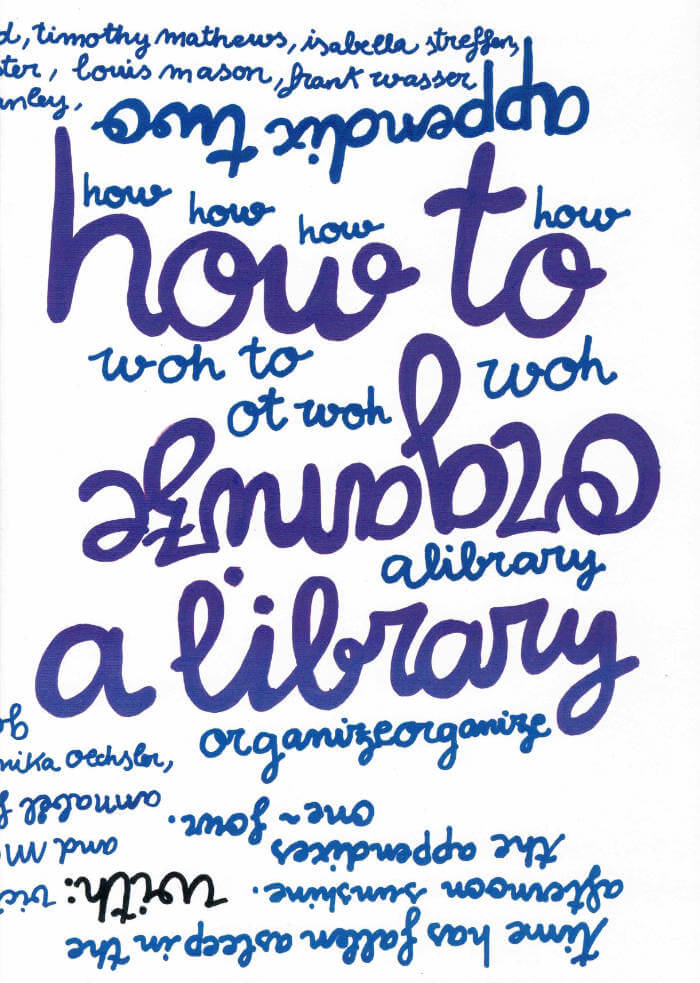
Time has fallen asleep in the afternoon sunshine
Appendix #2 - How to organize a library
Mette Edvardsen, Léa Poiré and 1 more
The Appendixes #1–4 is an editorial series by Mette Edvardsen, Léa Poiré and Victoria Pérez Royo that developed out of the project Time has fallen asleep in the afternoon sunshine. For a two-year residency at Les Laboratoires d’Aubervilliers* (2022–23), they came together as a small work group, shaping the work process, hosting presentation formats and making this publication series on paper as four cahiers.
The cahiers comprise a collection of commissioned texts and contributions created for this context, selected documents and traces from work sessions and encounters organized during their residency, texts read together and republished for this occasion, a collection of references, notes in progress, unfinished thoughts and loose fragments – on paper, between pages.
The Appendixes are organized around four themes: (1) The gesture of writing, (2) How to organize a library, (3) Orality and (4) Translation. In addition to being published on paper, the editorial series also consisted of other formats of presentations, exchanges and meetings organized as workshops, fieldwork, performances, conferences, collective readings and oral publications, taking place during their residency at Les Laboratoires d’Aubervilliers and in the vicinity.

To After That (Toaf)
A warm-spirited elegy to an abandoned work, brilliantly comic and wryly contemplative, by one of the great artist-investigators of our time.
Originally published in 2008 in the groundbreaking Atelos series, To After That (TOAF) introduced a new kind of writing—somewhere between criticism and memoir and philosophy—that Renee Gladman has continued to explore in books like Calamities and My Lesbian Novel.
TOAF is a recuperative song, an effort to give space and life to an abandoned project, but it is also, itself, a beautiful meditation on process and distance and duration, and a reminder that time is the subject of any writing.
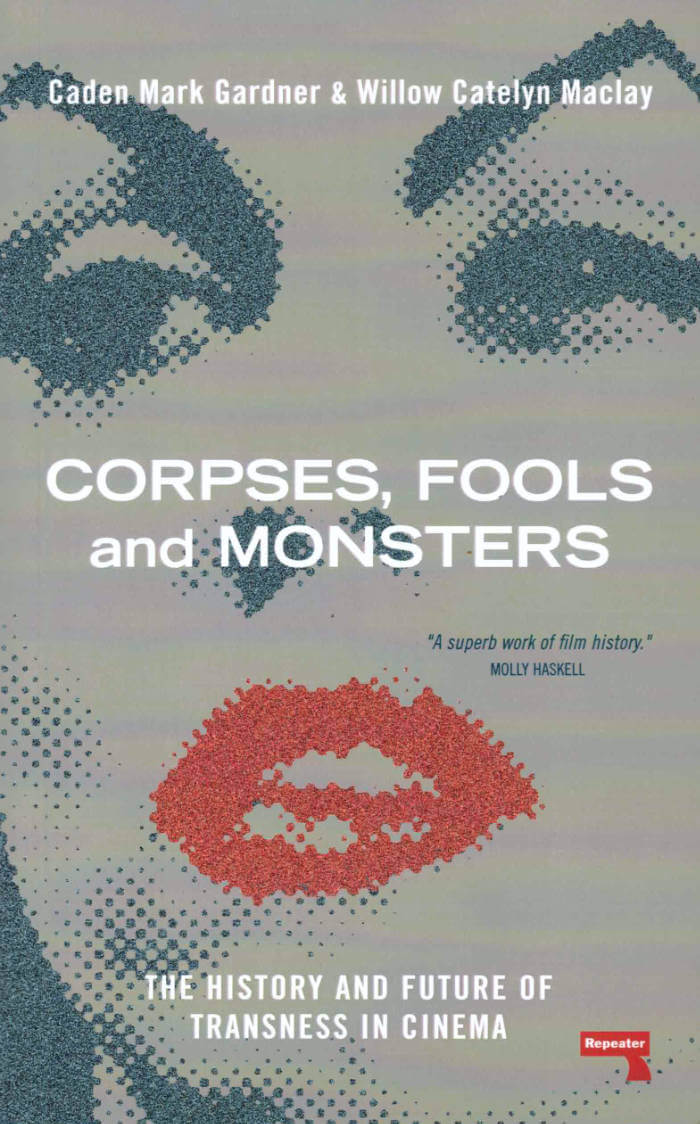
Corpses, Fools and Monsters: The History and Future of Transness in Cinema
A radical history of trans images in film, and an exploration of the political possibilities of the new trans cinema movement.
There have been trans images in cinema for over a century — very often bad cultural objects and very often inspired by the cultural zeitgeist, from Christine Jorgensen to Candy Darling to a guest on The Jerry Springer Show. But now, trans cinema as a movement is slowly emerging from the margins to create a new film language, often in reaction to these historical trans film images that cast the trans body in abject form; a corpse, a foolish joke, a tragic martyr, or even a monster.
Corpses, Fools, and Monsters is a new radical history of these trans film images, and an exploration of the political possibilities of the new trans cinema movement. Analysing the work of trans cinema directors Isabel Sandoval, Silas Howard, and the Wachowski Sisters, it also discusses the trans film image in everything from pre-talkie films and Ed Wood B-movies to Oscar-winners, body horror and slashers.
Going beyond reassessing notable films, performances, and portrayals, Corpses, Fools, and Monsters instead brings to light films and artists not given their due, along with highlighting filmmakers who are bringing trans cinema out of the margins in the twenty-first century.

Blackouts
Out in the desert in a place called the Palace, a young man tends to a dying soul, someone he once knew briefly, but who has haunted the edges of his life. Juan Gay—playful raconteur, child lost and found and lost, guardian of the institutionalized—has a project to pass along to this new narrator. It is inspired by a true artifact of a book, Sex Variants: A Study in Homosexual Patterns, which contains stories collected in the early twentieth century from queer subjects by a queer researcher, Jan Gay, whose groundbreaking work was then co-opted by a committee, her name buried. As Juan waits for his end, he and the narrator trade stories—moments of joy and oblivion—and resurrect lost loves, lives, mothers, fathers, minor heroes. The past is with us, beside us, ahead of us; what are we to create from its gaps and erasures?
Inspired by Kiss of the Spider Woman, Pedro Páramo, Voodoo Macbeth, the book at its own center and the woman who created it, oral histories, and many more texts, images, and influences, Justin Torres's Blackouts is a work of fiction that sees through the inventions of history and narrative. An extraordinary work of creative imagination, it insists that we look long and steady at the world we have inherited and the world we have made—a world full of ghostly shadows and flashing moments of truth.
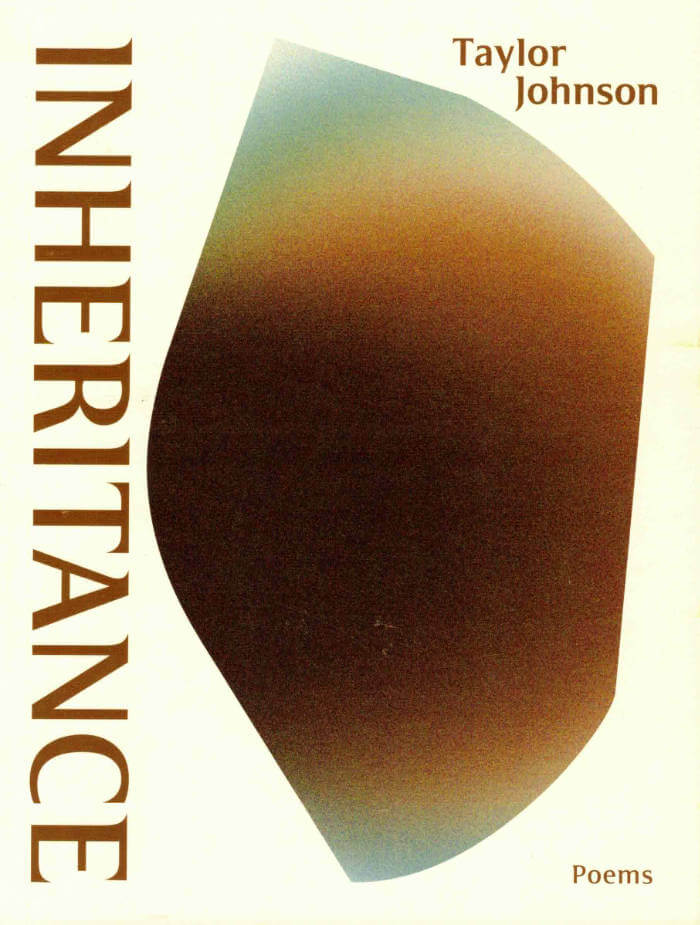
Inheritance
Taylor Johnson’s debut poetry collection, Inheritance, explores the complexities and limitations of language, physicality and capitalism. Resisting singularities, each poem emerges with a distinct sound, space and sensibility. Whether driving in a Lincoln Town Car; moving through pine forests and becoming immersed in the sounds of animals and nature; languishing in a lovers’ invitation, transcending from the syncopation of Go-go or walking the pavements of Washington D.C.—‘dissolving into sound’. Johnson’s critical perspective is rooted in connection. These poems gesture towards the tools we might need for living alongside rather than against or in spite of an inundation of daily oppressions. Be it redefining trans Blackness, environmental degradation, or land ownership and labour. With receptiveness and tenderness Johnson strolls around language, listening to silence—inheriting it, filling it and remaking it.

Quiet Fires
Quiet Fires, the debut poetry collection from andriniki mattis, queries the everpresent questions of Black lives. Be it in a bakery in Brixton, London, at a corner on Malcolm X Blvd, Brooklyn, or the pews of Notre Dame, Paris – whether crossing violent borders on land or in gender, we know how it is to be in a familiar place that feels foreign.
As we follow along on bike rides over the Manhattan Bridge or sit alongside queer lovers in Bushwick, mattis reflects on the profound impact of pandemics, indifference, and heartbreak. In these lyrical and intimate poems that interrogate white spaces on the page and in the world with evocative metaphors, we wonder: “is there ever a party if you're always working this skin”— where can we feel safe and loved? In a world of climate change and the constant “twilight of violence”, be it gun violence or the expectations of capitalism, quiet fires erupt in these errant everyday moments. Centered around the experience of the Black queer, trans body, andriniki gabriel mattis uncovers the complexities of identity and the quest for self-discovery.
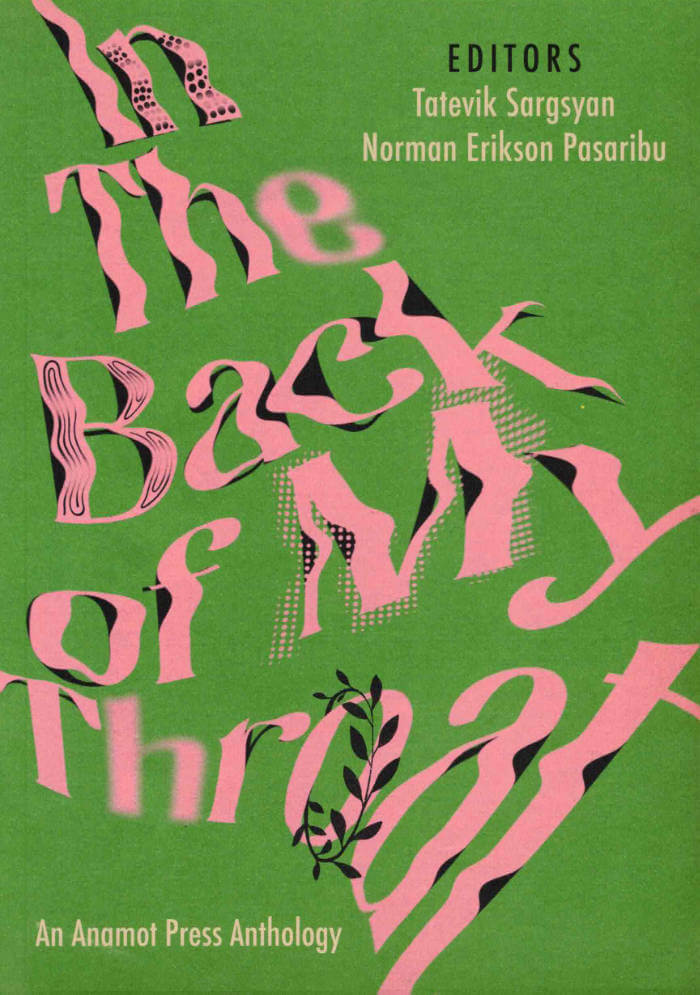
In The Back of My Throat
Norman Erikson Pasaribu, Tatevik Sargsyan
In The Back of My Throat is an anthology about queer Indonesian experiences across borders and other stories told with no shame.
Edited by Tatevik Sargsyan and Norman Erikson Pasaribu.
With contributions from: Zar Mose, Khairani Barokka, JR Hadi, Kristal Firdaus, Anna Sulan Masing, Pear Nuallak, Ko Ko Thett, Kyi May Kaung, Ziggy Zezsyazeoviennazabrizkie, Pychita Julinanda, Prahara Amelia, Madina Malahayati Chumaera, Nurdiyansyah, Mak Lin, Caesar Abrisam.
The title is taken from Prahara Amelia’s poem.
Norman Erikson Pasaribu is a Bali-based writer, translator, and editor. Their poetry collection My Dream Job will be out in the UK in 2024 with Tilted Axis Press.
Tatevik Sargsyan is founding publisher and editor of Anamot Press, Trustee of the Poetry Translation Centre and a design strategist working with charities and philanthropy.

La Captive
In the fifth published title of the Decadent Editions series, Christine Smallwood explores Chantal Akerman’s adaptation of Marcel Proust’s The Prisoner, the fifth volume of In Search of Lost Time, in a text that moves elegantly between Akerman’s films, Proust’s novel, and Smallwood’s own life.

A Garden Manifesto
What do gardens mean and how can they change the world? A Garden Manifesto gathers radical visions rooted in the earth from artists, writers, gardeners and activists, among them Lubaina Himid, Derek Jarman, Jamaica Kincaid, Ana Mendieta, Dan Pearson and Wolfgang Tillmans. It’s a seed box for an uncertain future, packed with anarchic dreams of Eden-making and humming with resistance to the colonial project of homogenisation and destruction.
Featuring William Blake, Joe Brainard, Jonny Bruce, John Clare, Gerry Dalton, Ellen Dillon, Baha Ebdeir, Alys Fowler, Magdalena Suarez Frimkess, Gaylene Gould, Green Guerillas, Joy Gregory, Fritz Haeg, Lubaina Himid, Philip Hoare, Rosie Hudson, Derek Jarman, Chantal Joffe, Laura Joy, Jamaica Kincaid, Elisabeth Kley, Olivia Laing, Jeremy Lee, Siobhan Liddell, Alison Lloyd, Hilary Lloyd, Jo McKerr, Lee Mary Manning, Ana Mendieta, Bernadette Mayer, Rosemary Mayer, Huw Morgan, Eileen Myles, Hussein Omar, Palestinian Heirloom Seed Library, Ian Patterson, Dan Pearson, Jean Perréal, Charlie Porter, Pat Porter, J. H. Prynne, Claire Ratinon, Jamie Reid, Lisa Robertson, Kuba Ryniewicz, Saadi, Sui Searle, Sei Shōnagon, Colin Stewart, Tabboo!, Edward Thomasson, Wolfgang Tillmans, Scott Treleaven, John Wieners, David Wojnarowicz, Matt Wolf and Sarah Wood

The Glover Group – A Los Angeles Story
A portrait of the cohesive community of women artists in Frogtown, Los Angeles, including Ruby Neri, Hilary Pecis, Megan Reed, Lily Stockman, and Austyn Weiner.
The Glover Group: A Los Angeles Story narrates the journey of an extraordinary group of artists who have nurtured their unique artistic voices within the same studio complex in Frogtown, Los Angeles. The Glover Group includes Ruby Neri, Hilary Pecis, Megan Reed, Lily Stockman, and Austyn Weiner, a coincidental yet cohesive community of women artists sharing a unique bond through their interconnected workspace.
This catalog, designed to document their collaborative exhibition held at MASSIMODECARLO in Milan during July and August 2023, features interviews to the artists by Cecilia Alemani, Alison M. Gingeras, Justine Ludwig, Marta Papini, and Heidi Zuckerman, together with photographs by Tracy Nguyen.
Contributions by Ruby Neri & Alison M. Gingeras, Hilary Pecis & Cecilia Alemani, Megan Reed & Marta Papini, Lily Stockman & Heidi Zuckerman, Austyn Weiner & Justine Ludwig.
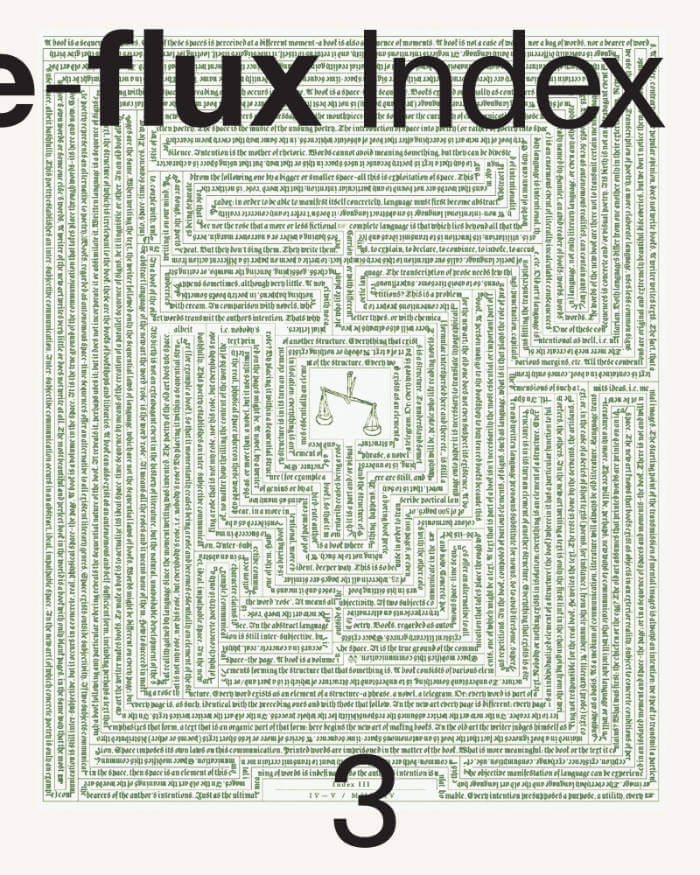
e-flux Index #03
76 contributions from an international selection of critics, artists, poets, architects, filmmakers, and theorists, published by e-flux between April–May 2024, arranged into 11 thematic chapters—ranging from the live question of cultural censorship through to the role of diagrams and notation in contemporary artistic practice.
540 pages long, this volume includes contributions from authors, artists, architects, filmmakers, poets, and theorists from many parts of the world. Ulises Carrión once declared that "In the new art every book requires a different reading"—an attitude which the Index here adopts in its approach to contemporary culture.
Contributions by Kwabena Appeaning Addo, Kimberly Alidio, Shouka Alizadeh, Corina L. Apostol, Aram, Arnavaz, Andrius Arutiunian, Robert Ashley, Goli Baharan, Stephanie Bailey, Oliver Basciano, Merve Bedir, Silvia Benedito, Pietro Bianchi, Alessandro Bosetti, Arno Brandlhuber, Nathan Brown, Boris Buden, Harry Burke, Rocio Calzado, Matevž Čelik, Adeline Chia, Ted Chiang, Canada Choate, Jace Clayton, Kim Cordóva, Ana Dana Beroš, Dasgoharan, Miri Davidson, Nuzhan Didartalab, Travis Diehl, Brian Dillon, Maria Dimitrova, Ben Eastham, Ren Ebel, Elaheh, Ludwig Engel, Future Foodscapes Research Unit, Ghoncheh Ghavami, Olaf Grawert, Boris Groys, Maddie Hampton, Negar Hatami, Jörg Heiser, Sandi Hilal, Daisy Hildyard, Juan José Santos, Nicole Kalms, Biljana Kašić, Tamta Khalvashi, Alina Kolar, Mo Michelsen Stochholm Krag, Cat Kron, Agnieszka Kurant, Michał Libera, R.H. Lossin, Rômulo Moraes, Daniel Muzyczuk, Nahal Nikan, Tausif Noor, Bahar Noorizadeh, Alice Notley, Joe Osae-Addo, Parva, Octave Perrault, Alessandro Petti, Andreas Petrossiants, Filipa Ramos, Jacques Rancière, Robida, Aoife Rosenmeyer, Mika Savela, Debora Silverman, Daniel Spaulding, Jonas Staal, Kerstin Stakemeier, Ben Vida, Anthony Vidler, McKenzie Wark, Katrina Wiberg, Kaelen Wilson-Goldie, Jenny Wu, Osman Can Yerebakan, Vivian Ziherl.

Ticking Stripe
A new collection of writings by the composer and mathematician Spencer Gerhardt, considering among other topics the rich points of contact between minimalist musical aesthetics and intuitionistic mathematics.
Noted composer and mathematician Spencer Gerhardt presents Ticking Stripe, a groundbreaking collection of essays linking notions of continuity and construction across the boundaries of math, art, music and philosophy. Gerhardt offers new, and deeply informed interpretations of the 1960s New York avant-garde, viewed through the lens of trailblazing artists such as La Monte Young, Marian Zazeela, Catherine Christer Hennix, Henry Flynt and Tony Conrad.
Ticking Stripe pairs the spirit of L. E. J. Brouwer—a mathematician who brilliantly, and controversially, sought to reconstruct the continuum in his own philosophical terms called intuitionism—with the ambitions of pioneering minimalists who combined continued constructions, idealized processes of introspection, and conceptual world-building with a host of philosophical, scientific, and spiritual concerns. Informed by his own work as a professional mathematician and composer, Gerhardt explores the depths of these disparate traditions, finding unlikely areas of commonality. Spanning over two decades, these essays feature rich historical explorations of minimalist music, writing on contemporary art, and work in logic and algebraic groups, all approached with rare clarity and technical aplomb.
Spencer Gerhardt is a composer and mathematician. His music engages constructive, introspective and romantic traditions. Gerhardt has written solo piano music, piano based songs, and works of minimalism. He studied raga with La Monte Young and Marian Zazeela, piano performance with Sung-Hwa Park, and has collaborated with artists such as Thomas Ankersmit and Charles Curtis.

Sweat Shame Etc.
Across objects, writing, sound and choreography, British artist Cally Spooner addresses the manners in which specific technological and financial conditions shape and organize life. This volume surveys her artistic output of the last five years.
Sweat Shame Etc. includes a lecture by Spooner along newly commissioned essays by Laura McLean Ferris, Pierre Bal-Blanc, and Lucrezia Calabrò Visconti. A 2018 series of drawings on paper, from which the monograph takes its name, features hastily sketched figures that take care of their bodies while shedding clothes, socks, limbs, and torsos. Though their heads are scratched out, they remain unexpectedly determined and unperturbed.
Published following the eponymous exhibition at the Swiss Institute, New York, in 2018-2019.
Cally Spooner (born 1983 in Ascot, UK, lives and works in London and Turin) is an artist who exhibits performances that unfold across media—on film, in text, as objects, through sound, and as illustrated in drawings.
Edited by Alison Coplan and Laura McLean-Ferris.
Texts by Pierre Bal-Blanc, Lucrezia Calabrò Visconti, Laura McLean-Ferris, Cally Spooner.

Film Undone – Elements of a Latent Cinema
Film Undone presents contributions introducing unmade and unfinished film projects, film ideas realised in non-filmic media, as well as films that remained unseen in their intended form and at their intended time.
These tentative and careful probes dedicated to singular projects reflect the importance of primary materials before and beyond the film. Bringing them together as Elements of a Latent Cinema opens a space to consider cases from various political geographies and historical moments in relation. Latency prompts to think differently about what has remained invisible in cinema than under deficit-centred categories such as failure, loss, or incompletion. It marks a sustained potentiality for things to change their condition, to affect us and set us in motion.
Contributions by Alejandro Alvarado, Carmen Amengual, Annabelle Aventurin, Alia Ayman, Concha Barquero, Petra Belc, Uliana Bychenkova, George Clark, Greg de Cuir Jr, Shai Heredia, Tobias Hering, Tom Holert, Katie Kirkland, Olexii Kuchanskyi, Brigitta Kuster, Dhianita Kusuma Pertiwi, Léa Morin, Tara Najd Ahmadi, Ojoboca, Uriel Orlow, Volker Pantenburg, Lisabona Rahman, Mathilde Rouxel, Bunga Siagian, Oleksandr Teliuk, Elena Vogman, Akbar Yumni

Breaking Cinema – Experimental Film 2010-2023
A significant contribution to the understanding of the work of artist and filmmaker Cauleen Smith, by art historian Romi Crawford, who analyzes how Smith recastsfilm history, in a pivotal period of her career.
Operating in multiple materials and arenas, Cauleen Smith roots her work firmly within the discourse of mid-twentieth-century experimental film, and makes things that deploy the tactics of these disciplines while offering a phenomenological experience for spectators and participants. The book Breaking Cinema. Experimental Film 2010–2023 adds to the growing scholarship on Cauleen Smith's work, as art historian Romi Crawford elucidates a critical phase of the artist's career and how Smith recasts film history in the context of the artistic and cultural ferment of Chicago's South Side.
Cauleen Smith (born 1967 in Riverside, CA) is an American filmmaker and artist. Her interdisciplinary work expands from histories and practices of experimental film, including structuralism, Third World cinema, and science fiction. Through immersive installations, moving-image works, sculpted objects, and textiles, she engages with non-Western cosmologies, Afro-diasporic histories, Black cultural icons, real and speculative utopias, and, in her words, "the everyday possibilities of the imagination."
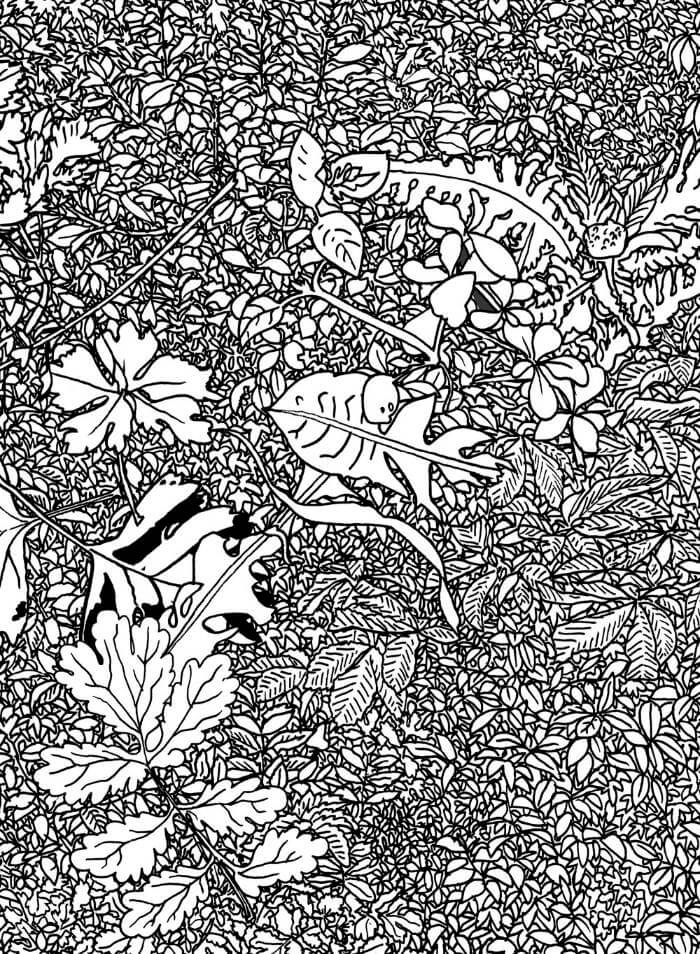
Mille Feuilles
Ingo Giezendanner's wild herbarium.
Density in the foliage, branching of the tree, structure in the bark: this book is entirely dedicated to organic, wild-growing greenery, mostly in black and white, but patterns emerge, the leaves become a frenzy, and grimaces from the thicket smile at us. The volume is deliberately overwhelming, making it impossible to get an overview. Rather this thick paperback serves as a reference for untamable, rampant, sprawling kraut.
Since 1998, Ingo Giezendanner, alias GRRRR, has been documenting the urban spaces in which he has travelled and lived. Apart from his native city of Zurich, his travels have taken him to diverse cities from New York and New Orleans to Cairo, Nairobi, Karachi and Colombo. Everywhere he travels, he captures his surroundings on location with pen on paper. His drawings have been presented in numerous magazines, books and animated films as well as in spacious installations and wallpaintings.

Not a Force of Nature
If capital makes life a seething, complex nightmare for most people on the planet's surface, if "words do cleave the producer from the land," then what does all this dispossession feel like? Amy De'Ath turns poetry into a hot, potent, and highly funny form of criticism, in which social force is felt intimately, and voiced in the acid niceness of a work email. Amy's poems move like pieces of machinery in a cognitive amusement park, which spit you a thousand feet into the air but keep your viewpoint fixed on the same spot as before—what's different? "Land in Saskatchewan, land in Delhi," or "everything…that you want from women and gays." Not a Force of Nature makes me want to change everything. "Behold me I'm you now," Amy writes—we should be so lucky, to be thus transformed. — Kay Gabriel
Not a Force of Nature's expertly crafted poems explore the catastrophe we live among and speak through. They form a sort of feminist manifesto addressed to all forms of resistance. But also: here are love sonnets! This book is angrily precise and always a lot of fun. "No, you're a Canadianist!" — Kevin Davies
Not a Force of Nature is the kind of book that becomes possible only after rejecting the "we" evoked so often in contemporary literary culture—sometimes said to need poetry now more than ever, sometimes called community. Amy De'Ath's motley vision of solidarity, of "actual emboldened people," is way weirder, more lively, and possible. Nor do these poems content themselves, like the ghost of Marxist theory past, with pointing towards the contradictions that surround them. Do you remember email? Sonnets? Not a Force of Nature is like that, thrashing inside generic forms and always coming next: after the tendency of the rate of profit to fall, after Jane's abortion service, after the 1970s, 80s, and 90s, after Creeley, after Raworth, after Mayer, after the Xenofeminist Manifesto, after Pluto enters Aquarius. "There are still tactics like this roaming free," De'Ath writes. There are still these fervent lyric parries. Be with Not a Force of Nature now. — Stephanie Young
Through slips of verbal acuity, Amy De'Ath scrapes her way out of determinism to a world "made by hands," where our material relations are ours to make and break. History is long and history is short. History is translucent. De'Ath presents the Ferris wheel of capitalist production, where the subject lives once as worker, twice as commodity. Here, in these "concrete trousers," is a "totally liberated" working class poem turning everything into nothing as praxis. — Anahita Jamali Rad